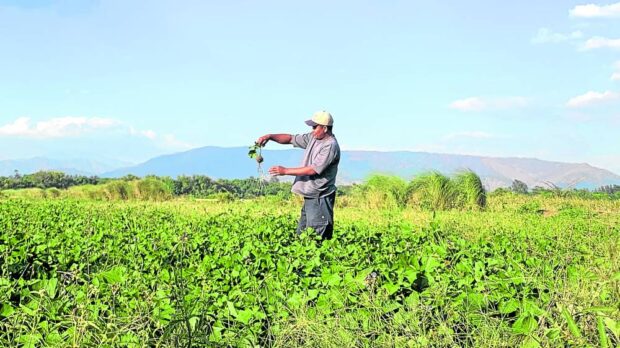Drought hits Bataan, Zambales; crop losses in Negros at P14.4 million

FARM INSPECTION A turnip farmer, in this photo taken on Tuesday, checks a plantation bordering San Marcelino and San Antonio towns in Zambales amid the scarcity of rain. Farmers in Central Luzon are reeling from the impact of the drought and dry spell accompanying the El Niño phenomenon. —JOANNA ROSE AGLIBOT
Drought triggered by the El Niño weather phenomenon, or the unusual warming of surface waters in the eastern tropical Pacific Ocean, has hit the provinces of Bataan and Zambales, a Department of Agriculture (DA) official said.
In a report, Lowell Rebillaco, DA regional field office focal person for disaster risk reduction and management, confirmed that the two Central Luzon provinces were “experiencing drought” while Aurora, Nueva Ecija, Pampanga and Tarlac “were already under dry spell condition.”
The report has yet to cite the extent or cost of damage to the local agriculture industry resulting from the drought or how farmers, livestock or poultry growers and fisherfolk are managing the situation.
According to him, field monitoring reports matched the climate outlook released by the Philippine Atmospheric, Geophysical and Astronomical Services Administration (Pagasa) during the 168th Climate Forum for February until July this year.
Damaged rice farms
Pagasa, in its website, says a dry spell is characterized by “three consecutive months of below normal (21-percent to 60-percent reduction from average) rainfall conditions; or two consecutive months of way below normal (more than 60-percent reduction from average) rainfall conditions.”
Drought, on the other hand, occurs when there is “three consecutive months of way below normal; or five consecutive months of below normal rainfall conditions.”
To ease the impact of El Niño, the DA has reported reactivating a disaster task force, monitoring water levels in dams, updating planting and harvesting reports, mapping drought-vulnerable areas, increasing awareness of El Niño and alternate wetting and drying technology.
Rebillaco said the regional office has available buffer stocks of rice, corn and vegetable seeds, as well as biopesticides and biocontrol agents. It also encouraged the shift to corn, onion and other high-value crops. Rebillaco said onion and mango growers in Central Luzon stand to benefit from minimal rains. In Negros Occidental, damage to rice farms due to the dry spell has risen to P14,474,887, government reports showed.
Gov. Eugenio Jose Lacson on Wednesday said the losses in the province affected 383 farmers who tilled 369 hectares in 43 barangays.
Cauayan town was worst hit with damage to crops reaching P7.6 million followed by Hinoba-an with P2.5 million. Himamaylan City reported losses at P2.4 million, Sipalay City at P535,658, Binalbagan town at P513,360, Moises Padilla town at P450,897 and Isabela town at P334,800.
Water conservation
Lacson said Dennis Arpi, DA regional director in Western Visayas, assured him that cloud seeding would be done in Negros Occidental.
The provincial government, the governor said, will use its savings to assist farmers affected by the dry spell.Meanwhile, Defense Secretary Gilberto Teodoro Jr., who also chairs the government’s Task Force El Niño, directed commanders of military camps across the country to implement tighter measures to conserve water.
Teodoro, in a statement released by the Presidential Communications Office, stressed the importance of practicing the government’s water conservation policy amid the dry season.
He reminded commanders of military camps to repair facilities, like leaking pipes, to prevent wastage.
“All military personnel and their dependents living inside military camps must do their part in the whole-of-government approach to mitigate the effects of El Niño,” Teodoro said. —WITH A REPORT FROM JULIE M. AURELIO